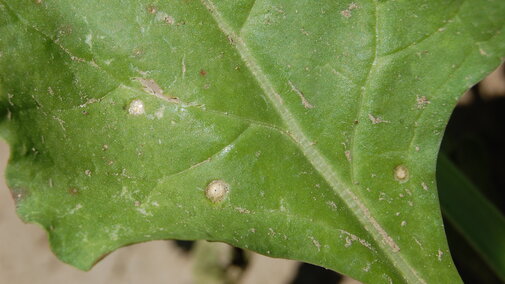Cercospora leaf spot (CLS) has long been problematic to sugar beet production throughout the eastern and Great Lakes production areas of the United States. In western Nebraska, it has been sporadic, but not a consistent issue. However, when it does occur, it can be very destructive.
Cercospora leaf spot is caused by the airborne fungal pathogen Cercospora beticola. This pathogen overwinters in infected residue and can serve as an inoculum source the following season. Disease development is strongly dependent on specific environmental conditions. These include:
- periods of high humidity or extended leaf wetness (more than 11 hours) and
- warm temperatures (higher than 60° F at night and 80-90° F during day).
Without these conditions, disease spread and damage to beet crops is greatly reduced or inhibited.
The fungus grows within leaf tissues and new lesions and spores will be formed within 10-14 days under optimum conditions. This means that whenever you see the circular, ash-colored lesions (1/8 inch in diameter) surrounded by a dark border, infection occurred approximately two weeks earlier.
On Monday morning (July 15) the symptoms characteristic of this disease were observed on the lower leaves of sugar beets in research plots at the university’s Panhandle Research and Extension Center in Scottsbluff. This suggests that infection occurred before the 4th of July, which is incredibly early for this to happen in western Nebraska. This also implies that many of the new leaves may already be infected, but not exhibiting symptoms yet. Infection of the newer, upper leaves is where the economic loss occurs in both tonnage and sugar content.
Scouting Recommended
Be on the lookout! It is definitely time to begin scouting fields closely, looking for similar symptoms. It is unusually early, but fungicide applications may be necessary if it continues to rain and stay warmer at nights between midnight and 6-7 am. This is a devastating disease if it becomes established and is difficult if not impossible to properly manage. You can never play catch-up with this disease.

